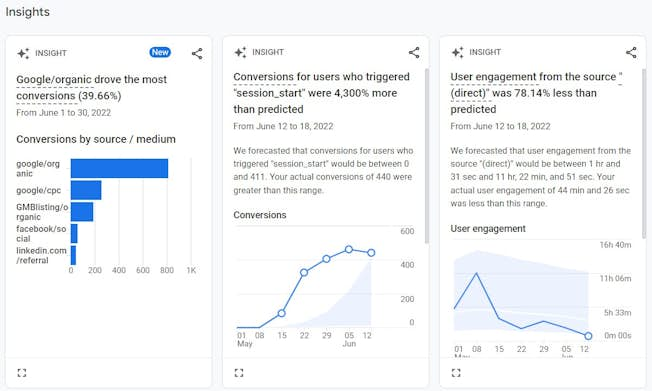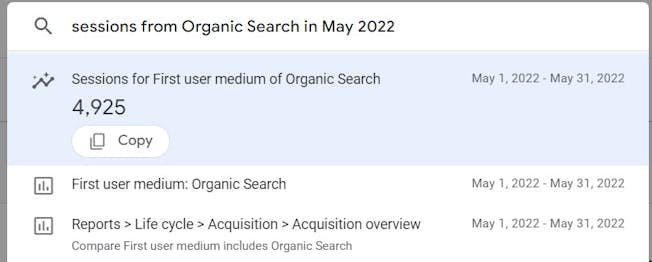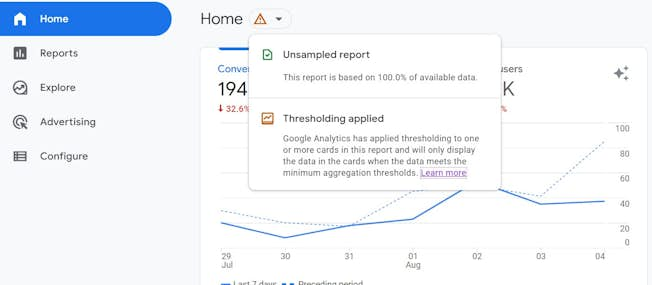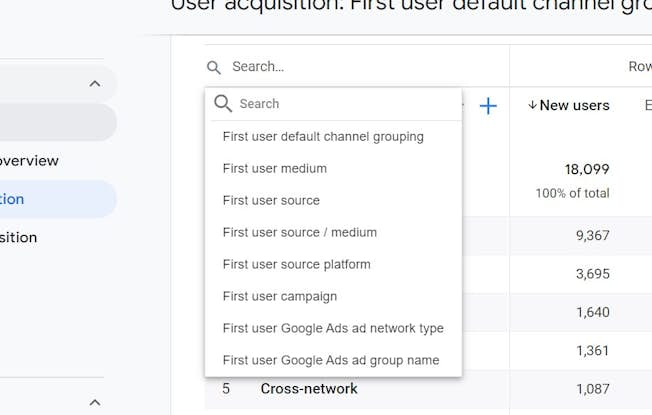Mar 30, 2022
A Guide to GA4 vs Universal Analytics
Google Analytics has always been the go-to platform for most anyone working in digital marketing, to measure and track site and campaign performance and to ultimately understand their customers.Up until 2020 the interface was known as Universal Analytics (UA). It is being superseded by Google Analytics 4 (GA4) and indeed UA will be fully retired by 2023.
It's clear that GA4 is here to stay and it will soon be the only Analytics platform from Google. So whether you're a fan, or not, now is the time to migrate your website from UA to GA4! Many users of UA have found the transition to GA4 to been painful and it gets put on the back burner. We will look here at the key differences between UA and GA4 and issues people have found, including the less-intuitive interface and difficulty in finding or creating the reports we’re all used to using day to day.
We will cover:
- What is GA4?
- What’s new in GA vs UA4?
- How does GA4 compare to UA?
- Preparing for the end of UA
You can also check out our other GA4 detailed guides here, so, when Google shuts down UA, you'll be ready to hit the ground running with GA4.
“You won’t be able to use Universal Analytics to track your website data from July 2023 and historical reports and data will be deleted from the tool in 2024.”
What is GA4
Google Analytics 4, known as GA4, is the latest iteration of Google Analytics and was launched in October 2020. Unlike previous versions of Google Analytics, i.e. Classic Analytics, (launched 2005) and Universal Analytics, (launched 2012), GA4 is not built to measure website visits or sessions: rather it is built to measure website and mobile app interactions, known as events.
This is important as it gives marketers deeper insights into the types of actions people take on a website, not just the visit and what pages they looked at. While events are available in Universal Analytics, they can be difficult to set up for non-technical marketers or those with limited knowledge of tools like Google Tag Manager. This meant that a lot of important page interaction data was not reported automatically in Universal Analytics. GA4 aims to address this.
Furthermore, tracking page interaction events were not the primary metric or measurement focus of older versions of Google Analytics which focused simply on visits. So GA4 puts events at the center of its tracking and this gives access to deeper understanding for all marketers, regardless of their technical capabilities.
What’s new in GA vs UA4?
There are important differences between GA and UA4 and we will be discussing these differences as we walk you through the importance, configuration, and uses of GA4. But first, here is a snapshot of the key differences between the platforms:
- UA needed cookies to run, GA4 doesn’t. Alongside cookie tracking, GA4 comes fully equipped to comply with Consent mode and will offer behavioral modeling.
- UA was built for session tracking, GA4 was built for user tracking (across multiple sessions and devices). That is tracking individuals and their actions instead of total visits.
- UA supports multiple views, GA4 doesn’t support multiple views though this may change
- UA stores data for up to 50 months, GA4 stores event data for up to 14 months (which saves resources for Google)
- UA has more standard reports - GA4 has fewer standard reports but supports more custom-built reports through Explorations
- UA processes events in under 4 hours, GA4 takes up to 72 hours to process them (this saves resources for Google’s servers)
We can noticeably see critical differences between the two platforms and how they operate. But are these differences a welcomed change or a cumbersome mandate? We have to compare the platforms to be able to answer that question.
How does GA4 compare to UA?
We are all assuming that the fact that Google decided to replace UA with GA4 means that GA4 is superior to UA. But is this really the case? We have compared the platforms to see how they fare against one another.
Why is GA4 better?
Here are the main areas where GA4 becomes a welcome development for digital marketers used to using UA.
1. Privacy
GA4 gives brands more control over how they collect, process and store the data of their users. When collecting data, GA4 does not log or store any IP addresses. GA4 will also provide controls to disable the collection of Google-signals data, location or device data, on a per-region basis.
2. Cookie-less Tracking
GA4 is designed to adapt to a future that doesn’t rely on cookie-based tracking. While GA4 does use cookies too, it also has the capability to work without cookies. To counter the missing cookies and data, GA4 uses Machine learning and Artificial Intelligence to fill the gaps and provide you with the complete picture.
Top tip: Read more about getting ready for a cookieless world in our DMI webinar
3. Customer-centric Measurement
Is GA4 better at tracking users and customers compared to UA? GA4 uses multiple ways of identifying customers to give a more complete view of users during their purchase journey across multiple devices. Since the platform was built to track both Websites and Apps under a single platform, it will recognize when the same user that visits an ecommerce app to view some products, adds them to a cart, but later finishes the purchase via a traditional desktop or mobile web.
4. Machine learning insights
Because GA4 is built with the power of Google’s Machine Learning at its core, it automatically uncovers insights from your data that will improve your marketing performance. Widgets placed in the GA4 dashboard will help uncover a lot of useful insights, such as traffic channels that are not behaving in a predicted way, or if there are spikes from different channels or cities etc. These widgets are predominantly found in the overview sections of the various pre-built life cycle or user report types.

Another very useful feature made possible by Google's machine learning technology is that you can actually type in questions and GA4 will show you the information you are likely to be looking for.
For example, you can find out how many sessions you had from organic search in a particular month:

Why is UA better (or GA4 worse)?
Why do some marketers prefer UA to GA4? Many marketers have already become aware of the limitations and user interface changes in GA4. Let’s have a look at some of the main issues.
1. “Limited” views and conversions
Because views aren’t supported anymore, you’re limited to 30 conversions (formerly goals in UA), which for big websites can be a problem. The good news is that GA4 supports up to 500 custom events, and each event can be analyzed separately (for conversion rates, for example), but if you plan to use them in Google Ads as conversions, then you’ll have to pick one of the maximum 30 available. You can also unassign some goals from conversions and put others in place, at any time.
Another issue is access: in UA you could have access for a certain view, but in GA4 access has to be given to the entire GA4 property and all the goals contained in that property.
2. Limited integrations
Search console linking was added much later to GA4 and the Google Ads linking doesn’t give you the same reports as UA. These two reports are accessed as widgets in the overview section of the acquisition overview and provide different metrics than what we are used to in UA.
3. Missing Annotations
Annotations were an important part of UA as it allowed you to make notes of when changes were done to the website and GA. These haven’t yet been added to the GA4 interface.
4. GA4 is slow to process traffic
Because it takes up to 72 hours for traffic to be processed, you can’t analyze data for the last few days as quickly as in UA. Plus, thresholds are applied to events. In order to get accurate data you will have to link to BigQuery and continuously export data and run reports (paid). BigQuery is Google’s data warehouse which uses SQL queries to pull data, so an additional skill set will be required to extract and interpret historical data from your GA4.
There is a way to test events when implementing them in the DebugView panel, so that way you’re sure that they’re working the way they’re intended, but if you’re publishing new events and expect to see them right away, expect at least a day of delay until you’ll see them in the main reports.
5. Thresholding
Possibly the most frustrating aspect of GA4 is that thresholding is sometimes applied to reports so you will have mismatched data between your channels, reports, and dimensions.
Thresholding is where GA4 limits the amount of data in your reports and you might notice things like significantly different cost metrics between the Google Ads interface and the Google Ads GA4 report. Likewise, you might also start noticing significant differences between GA4 and Universal Analytics user totals.

One way to ensure your reports aren’t subjected to thresholding is to go to the reporting identity in the admin area and select “Show All” then choose Device Based method from the options.

6. Predefined channels
Another reason why some marketers are saying that GA4 is harder to use than UA is because of predefined channels. This means that in GA4, there is no option to change them yet. Google Organic and Bing Organic will go to Organic Search. Google Ads and Bing Ads will go to Paid Search. But unlike UA where you could define and create your default channels so you could do things like create separate default channels for Tik Tok, Instagram or LinkedIn rather than having all metrics go into the Paid Social channel in GA4, this customization option isn’t available in GA4 yet.
We can however use the first user or session source/medium dimension in user and traffic reports to see more details about the traffic sources.

With that in mind, a lot of features are being added constantly, such as Bounce Rate which was added in Spring 2022.
What we can gather from these differences is that GA4 is not just a direct update to UA, but a platform that is built in a fundamentally different way to UA. Now, we all have our views and preferences, but the truth is that GA4 is here to stay and it does offer many new opportunities.
Preparing for the End of Universal Analytics
So, transitioning from our much loved (or despised) Universal Analytics might have seemed daunting when Google first launched GA4, as many of the reports we use all the time were not available. Since launch, much of the limited reporting has been addressed, which makes GA4 a perfectly good tool to start reporting on website activity today. And from someone who’s been using Universal Analytics from the time it was Classic Analytics, when you get used to the GA4 reporting navigation, you’ll see it’s not all that bad!
When transitioning from Universal Analytics to GA4 the main points to be mindful of are:
- Add GA4 in parallel with Universal Analytics until you fully transition
- Set up conversions and validate the numbers against Universal Analytics
- Use GA4 conversions in Google Ads
- Get familiar with the report navigation and find your reports through the overview sections
- Use Filters to focus in your most important data points
Find out more from the official getting-started list from Google.
Related
Upgrade to Power Membership to continue
your access to thousands of articles, toolkits, podcasts, lessons and much much more.
Become a Power Member- Login
- View Courses
- - - -
- Courses
- Resources
- - - -
- My Account
- Change Password
- Logout





